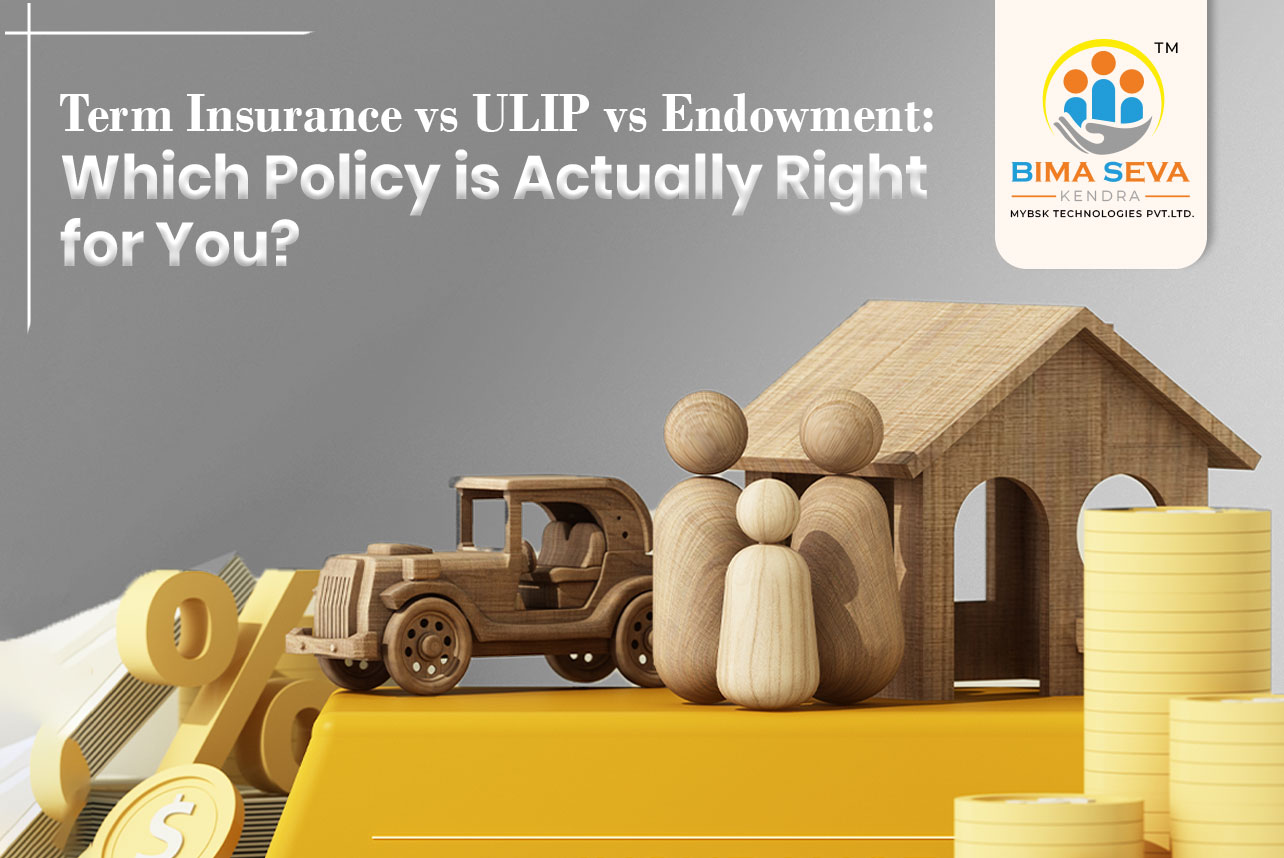
“ सेवा, सुरक्षा और समाधान ”

Term Insurance vs ULIP vs Endowment: Which Policy is Actually Right for You
If you’ve ever felt lost in the maze of insurance products, you’re not alone. Whether you’re landing your first job, planning a family, or simply trying to secure your financial future, choosing between term insurance, ULIP, and endowment plans can feel overwhelming.
But making the wrong choice can cost you not only money but also peace of mind, and in some cases, expose you to insurance claim-related issues, frustrating delay in claim process, or even claim rejections when your family needs support the most. Let’s break down each option clearly so you can decide what truly fits your goals and lifestyle.
1. Term Insurance: Pure Protection, Nothing Else
What it is:
Term insurance is the simplest type of life insurance you can get. It covers you for a set amount of time. In exchange for your yearly premium, the beneficiary will get a lump sum payment in the event that the policyholder passes within the policy's term.
Who it’s best for:
● Young professionals with limited budgets who need high coverage at a low cost
● Families where one person’s income supports everyone else
● Individuals who already have separate investments
Benefits:
● Affordable premiums
● Transparent and simple
● Tax benefits under Section 80C
Drawbacks:
● No maturity benefit—there’s no payout if the policy expires without the death of the holder within its term
● Unlike some permanent life insurance policies, term insurance does not accumulate a cash value that can be borrowed against or withdrawn.
● If you don’t disclose pre-existing conditions properly, you risk claim rejection-related issues.
A Note from the Experts: Many families in India have relied on term insurance as their financial backup. However, in numerous claim settlement disputes, insurers have pointed to non-disclosure or misrepresentation during the application. Always be honest with your insurer to avoid insurance claim-related issues or claim rejections.
2. Unit Linked Insurance Plan (ULIP): Insurance Meets Investment
What it is:
ULIPs are hybrid policies that combine life cover with market-linked investments. A portion of your premium funds is insurance, and the rest is invested in equity, debt, or balanced funds.
Who it’s best for:
● Young professionals with long-term goals (child’s education, wealth creation)
● Investors comfortable with market risk
● People willing to stay invested for 10–15 years
Benefits:
● Dual advantage: protection + wealth creation
● Flexibility to switch funds according to one’s risk appetite
● Tax benefits under Section 80C and partial withdrawals after 5 years
Drawbacks:
● Complex Premium allocations (fund management, mortality, policy admin fees)
● A typical lock-in period of five years.
● Returns are market-dependent; no guaranteed maturity amount
● The complex structure can lead to mis-selling of insurance policies by agents who oversell returns.
3. Endowment Plan: Guaranteed Returns with Insurance
What it is:
Endowment policies are traditional life insurance contracts that offer a mix of savings and protection. If the policyholder survives the term, they get a lump sum payout. In the event of their unfortunate passing, their nominee receives the death benefit.
Who it’s best for:
● Risk-averse individuals who prefer guaranteed returns
● Those who don’t want market exposure.
Benefits:
● Predictable maturity amount
● Tax benefits under Section 80C and Section 10(10D)
● Endowment plans accumulate cash value over time, with the savings component growing through regular premium payments.
Drawbacks:
● Lower returns compared to ULIPs or mutual funds
● Rigid structure—premature exit can result in heavy penalties.
● Higher premiums due to the savings element of the plan
4. Key Differences at a Glance
| Feature | Term Insurance | ULIP | Endowment Plan |
| Primary Purpose | Protection only | Protection + Investment | Protection + Savings |
| Maturity Benefit | None | Fund Value | Guaranteed + Bonus |
| Returns | None | Market-linked | Low but guaranteed |
| Premium | Lowest | Moderate | High |
| Flexibility | High | Moderate (switch funds) | Low |
| Risk High | None | Medium to High | High |
5. How to Choose Without Regret
Before you commit, ask yourself:
Do I need pure life cover, or am I looking for investment returns?
How comfortable am I with market volatility?
Can I commit to paying premiums for 10–20 years without disruption?
Am I clear about all exclusions and fine print?
➔ If your main priority is financial security for your family, term insurance is often the simplest and most efficient tool.
➔ If you’re aiming for wealth creation with discipline and don’t mind market risk, ULIPs can work—but only if you understand the costs and commit long-term.
➔ If guaranteed returns and predictable payouts matter most, endowment plans may suit you, provided you’re okay with modest growth.
6. Avoid Common Pitfalls
Many young policyholders face delays in the claim process or even outright claim rejections because they:
● Failed to disclose lifestyle habits (smoking, drinking)
● Didn’t mention existing health issues
● Didn’t update nominees after major life events
● Relied solely on the agent’s pitch without verifying details
Remember: Insurance is a promise, and that promise only holds if your information is accurate and complete.
Final Thoughts
Selecting the right policy isn’t just a financial decision—it’s a commitment to your family’s well-being. Take your time. Read the documents line by line. Compare products objectively. If you’re unsure, consult a subject matter expert to avoid costly mistakes or disappointment later.
Because in the world of insurance, an informed choice today can mean fewer claim rejection services, less stress, and lasting peace of mind tomorrow.
© 2025 MYBSK All Rights Reserved. Designed By SKALY INFOTECH PVT.LTD.
